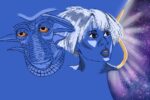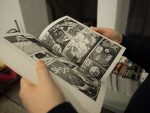For those unfamiliar with the world of comic books, Scottish-born writer Grant Morrison has become renowned among comic readers for his ingenious and often incredibly bizarre work. From his bloody fantasy-crime series “Happy!” to his redefining run on “Doom Patrol,” Morrison has managed to build beautifully surreal worlds time and again. Yet one of the most poignant stories he has ever written is also the most disturbingly realistic: the violent, profound and heartbreaking miniseries, “WE3.”
First published in 2004, “WE3” deals with a trio of animals who are kidnapped from their homes and experimented on as part of a secret military project. The animals consist of a dog, a cat and a rabbit, all of whom are stripped of whatever names they had before and instead given the designations “1,” “2” and “3,” respectively. Together, they form “animal weapon 3” or “WE3,” a prototype squad of cybernetically enhanced animals designed to eventually replace human soldiers.
The animals are each encased — or imprisoned — inside advanced mechanical armor and trained to use an array of built-in weaponry including machine guns, missiles, razor claws and land mines. More disturbingly, the trio is also given implants in their skulls which allow them a limited form of speech.
Although the concept of talking animals is often relegated to the realm of comedy, Morrison uses it to make a powerful statement about the inevitable horrors that unfold when humans attempt to play God. When 1 first speaks, it is not treated as humorous but as a sudden and shocking development. A close-up of the dog’s tired, emaciated face fills the panel as the poor animal attempts to ask a visiting senator if he “is gud dog” for killing the country’s enemies.
The senator’s initial reaction of horror is telling. While the project’s directors manage to get him to laugh it off, the point has been made. These animals should not be able to talk. The fact that they can is no miracle; an unwritten law has been broken.
The program’s head scientist, Doctor Trendle, sees nothing wrong with what has been done to the trio. After all, his goal, or, at least, his stated goal, is to “save the lives of countless men and women in [the] armed services.” Really, what is the life of a few animals compared to that of so many human beings?
However, the animals’ caretaker, Dr. Rosanne Berry, thinks differently from her superior. After it is announced WE3 will be decommissioned, Berry, guilt-stricken over what she has done and unwilling to see the three animals terminated, decides to set them free.
As the alarm sounds, the animals escape the compound, attempting to find the place they once knew as “home” through what vague recollections they have of their past lives. Unfortunately, the military is hot on their trail, and as Trendle laments the loss of human life that his “experiments” will soon cause, Berry can only look on in disgust.
“WE3” is a dark and bloody story. The animals face many dangers and must fight tooth and nail to defend themselves. But even though many people are killed by the trio before the story finally comes to a close, one never gets the sense it is entirely the animals’ fault.
Certainly, the three did not choose this fate for themselves. In their previous lives, they were but harmless pets. 1 was known as “Bandit,” a friendly, approachable dog, loved by his owner. 2 was “Tinker,” an alley cat cared for by a woman named Carla. 3 was “Pirate,” named by his family for the brown patch of fur around his right eye.
All three would have carried out their lives in peace had a group of humans not decided to turn them into weapons. But despite their existence as killing machines, the trio only ever kill humans when threatened. 1, or Bandit, actually goes out of his way to save a human’s life on more than one occasion.
Above all, the three’s greatest wish is to survive, being driven to do so by their most basic instinct. With seemingly the entire world against them, how else can they be expected to respond but like the frightened, cornered animals they are?
There is also something strangely beautiful in the trio’s struggle. While their human captors force changes onto them intended to make them tools of war, the animals are able to turn these changes to their own advantages.
The strong, loyal Bandit is made into a living tank, becoming a powerful protector towards his companions. The undermining and disobedient Tinker uses her newfound stealth capabilities to outmaneuver and confound her human attackers, further asserting her independence. The quick-footed Pirate is given both magnified speed and a mine-laying device, which only make him more difficult to catch.
Still, it should not be said that what has been done to these animals is a good thing. If the devastation the three inadvertently leave behind them is not evidence enough, their suffering at the hands of their cybernetics’ failsafes certainly should be. Even as the trio make their way towards “home,” they are slowly dying without a special medication created to keep them alive and subservient.
Despite possessing enough firepower to take on an entire human battalion, as the three trudge ever onward, they slowly but surely transform to resemble a group of battered, neglected animals that one would expect to find living in a shelter or on the streets.
“WE3” is not for the faint of heart. Morrison and artist Frank Quietly put together an extremely visceral tale, where animals are continuously the targets — and victims — of violence and where more than a little blood is spilled. The comic holds nothing back; it shows nature as “red in tooth and claw” where both humans and animals are concerned, with no apologies given.
Yet as violent as nature can be, never forget while reading: Everything in this story happens, not because of natural causes, but because of human intervention. Many lives could have been saved had humans simply let nature be nature.















